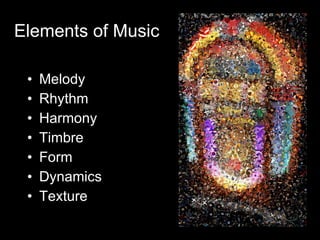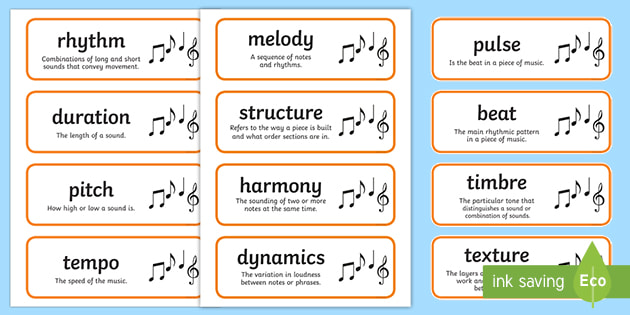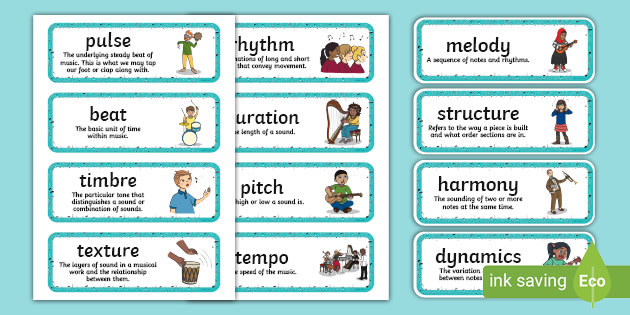Exploring The Wondrous Elements Of Music
Elements Of Music
Keywords searched by users: What are the elements of music Most important elements of music, Element of music, Nahre sol’s elements of music, What is melody in music, What is dynamic in music, What is music, What is texture in music, What is pitch in music
What Are The 12 Elements Of Music?
The 12 elements of music encompass a wide range of components that collectively shape the musical experience. These elements are fundamental to understanding and appreciating music in all its forms. The elements of music include:
-
Timbre: Also known as tone color, timbre refers to the unique quality or character of a musical sound. It helps us distinguish between different instruments and voices.
-
Texture: Texture in music describes the way different musical elements, such as melodies and harmonies, are combined to create the overall sound and feel of a piece.
-
Rhythm: Rhythm is the pattern of beats or time intervals in music. It forms the backbone of a composition, providing a sense of pulse and structure.
-
Melody: Melody is a sequence of single pitches that form a memorable and often singable tune. It’s one of the most recognizable aspects of music.
-
Beat: The beat is the regular, recurring pulse that gives music its sense of time and tempo. It’s what you tap your foot to when listening to a song.
-
Harmony: Harmony involves the combination of different musical notes played or sung simultaneously to create a pleasing sound. It adds depth and richness to music.
-
Structure: Structure refers to the organization of a musical composition, including its sections, repetition, and overall form. It helps make sense of a piece’s progression.
-
Tempo: Tempo is the speed or pace at which a piece of music is performed. It can greatly influence the mood and character of a composition.
-
Pitch: Pitch is the perceived highness or lowness of a musical sound. It’s determined by the frequency of vibrations and is essential for melody and harmony.
-
Dynamics: Dynamics relate to the variations in loudness and intensity within a piece of music. They help convey emotion and expression in a composition.
-
Form: Form encompasses the structure of a piece, including its sections and how they are organized. It can include elements like verses, choruses, and bridges in a song.
-
Tension and Release: This element explores the way music can create and resolve tension, often through techniques like dissonance and consonance, which add emotional depth to compositions.
Understanding these 12 elements of music is crucial for musicians, composers, and music enthusiasts alike, as they provide the vocabulary and concepts needed to analyze, create, and appreciate music across various genres and styles.
What Are The 8 Elements Of Music?
The 8 Elements of Music encompass various essential components that contribute to the richness and complexity of musical compositions. In alphabetical order, these elements are:
-
Dynamics: This element deals with the varying levels of volume and intensity within a piece of music, from soft to loud, adding emotional depth and contrast.
-
Form: Form relates to the overall structure of a musical composition, including the arrangement of its different sections, such as verses, choruses, and bridges.
-
Harmony: Harmony explores the combination of different musical notes played or sung simultaneously to create pleasing and harmonious sounds.
-
Melody: Melody represents the main, memorable tune in a piece of music. It’s the part you often find yourself humming or singing along to.
-
Rhythm: Rhythm is the heartbeat of music, defined by the patterns of beats and the duration of notes, giving music its groove and tempo.
-
Texture: Texture refers to the layering and interplay of different musical elements, such as melody, harmony, and rhythm, which combine to create a sense of depth and complexity.
-
Timbre: Timbre is the unique quality or color of a musical sound, allowing us to distinguish between instruments or voices even when playing the same note.
-
Tonality: Tonality is the system of organizing musical pitch in a piece, usually based on a particular key, giving it a sense of stability and hierarchy of notes.
Understanding these 8 elements helps to appreciate the intricacies and nuances of music, enabling listeners and musicians alike to connect with the emotional and artistic aspects of musical compositions. [Date last updated: October 11, 2020]
Update 16 What are the elements of music






Categories: Details 13 What Are The Elements Of Music
See more here: qua36.com

Elements of music include, timbre, texture, rhythm, melody, beat, harmony, structure, tempo, pitch and dynamics.The 8 Elements of Music are, in alphabetical order, Dynamics, Form, Harmony, Melody, Rhythm, Texture, Timbre and Tonality.Elements of music include, timbre, texture, rhythm, melody, beat, harmony, structure, tempo, pitch and dynamics.
- Sound (overtone, timbre, pitch, amplitude, duration)
- Melody.
- Harmony.
- Rhythm.
- Texture.
- Structure/form.
- Expression (dynamics, tempo, articulation)
Learn more about the topic What are the elements of music.
- Chapter 2: Music: Fundamentals and Educational Roots in the …
- What are the Elements of Music? – Resources & Information – Twinkl
- What are the 8 Elements of Music? – Jooya Teaching Resources
- What are the Elements of Music? – Resources & Information – Twinkl
- Elements of Music – ARTS:LIVE
- Chapter 2: Music: Fundamentals and Educational Roots in the U.S.
See more: https://qua36.com/category/cooking blog